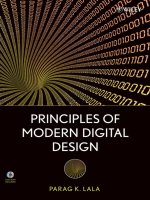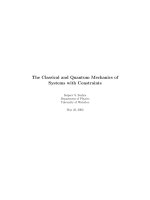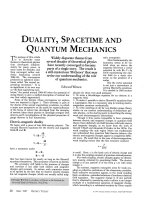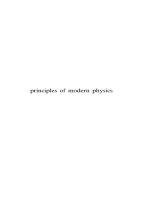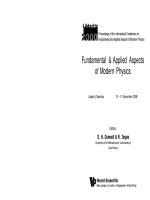- Trang chủ >>
- Khoa Học Tự Nhiên >>
- Vật lý
Relativity and quantum mechanics; principles of modern physics
Bạn đang xem bản rút gọn của tài liệu. Xem và tải ngay bản đầy đủ của tài liệu tại đây (4.12 MB, 65 trang )
www.pdfgrip.com
www.pdfgrip.com
Secrets of the Universe
b y Pa u l F l e i s h e r
s
L e r n e r P u b l i c a t i o n s Co m p a n y • M i n n e a p o l i s
www.pdfgrip.com
For India
Copyright © 2002 by Paul Fleisher
All rights reserved. International copyright secured. No part of this book
may be reproduced, stored in a retrieval system, or transmitted in any form
or by any means—electronic, mechanical, photocopying, recording, or
otherwise—without the prior written permission of Lerner Publications
Company, except for the inclusion of brief quotations in an acknowledged
review.
The text for this book has been adapted from a single-volume work entitled
Secrets of the Universe: Discovering the Universal Laws of Science, by Paul
Fleisher, originally published by Atheneum in 1987. Illustrations by Tim
Seeley were commissioned by Lerner Publications Company. New back
matter was developed by Lerner Publications Company.
Lerner Publications Company
A division of Lerner Publishing Group
241 First Avenue North
Minneapolis, MN 55401 U.S.A.
Website address: www.lernerbooks.com
Library of Congress Cataloging-in-Publication Data
Fleisher, Paul.
Relativity and quantum mechanics : principles of modern physics / by
Paul Fleisher.
p. cm. — (Secrets of the universe)
Includes bibliographical references and index.
eISBN 0-8225-0707-2
1. Relativity (Physics)—Juvenile literature. 2. Quantum theory—Juvenile
literature. [1. Relativity (Physics) 2. Quantum theory.] I. Title.
QC173.575.F54 2002
530.11–dc21
00-012110
Manufactured in the United States of America
1 2 3 4 5 6 – JR – 07 06 05 04 03 02
www.pdfgrip.com
Contents
Introduction: What Is a Natural Law? . . . . . . . . .6
1. Relativity . . . . . . . . . . . . . . . . . . . . . . . . . .10
2. Quantum Mechanics . . . . . . . . . . . . . . . . .21
3. Conservation of Mass/Energy . . . . . . . . .35
4. The Uncertainty Principle . . . . . . . . . . . .41
Timeline . . . . . . . . . . . . . . . . . . . . . . . . . . . . . . . .48
Biographies of Scientists . . . . . . . . . . . . . . . . . . .50
For Further Reading . . . . . . . . . . . . . . . . . . . . . .58
Selected Bibliography . . . . . . . . . . . . . . . . . . . . .60
Glossary . . . . . . . . . . . . . . . . . . . . . . . . . . . . . . . .61
Index . . . . . . . . . . . . . . . . . . . . . . . . . . . . . . . . . . .62
About the Author . . . . . . . . . . . . . . . . . . . . . . . .64
www.pdfgrip.com
I
NTRODUCTION
Everyone knows what a law is. It’s a
What Is
rule that tells people what they must or
must not do. Laws tell us that we
a Natural
shouldn’t drive faster than the legal
Law?
speed limit, that we must not take
someone else’s property, that we must
pay taxes on our income each year.
Where do these laws come from? In the United States
and other democratic countries, laws are created by elected
representatives. These men and women discuss what ideas
they think would be fair and useful. Then they vote to
decide which ones will actually become laws.
But there is another kind of law, a scientific law. You
probably have heard about Albert Einstein’s law of relativity, for example. Among other things, it tells us that nothing
in our universe can go faster than the speed of light. Where
did that law come from, and what could we do if we decided to change it?
The law of relativity is very different from a traffic
www.pdfgrip.com
www.pdfgrip.com
7
Introduction
speed limit or a law that says you must pay your taxes.
Speed limits are different in different places. On many
interstate highways drivers can travel 105 kilometers (65
miles) per hour. On crowded city streets they must drive
more slowly. But relativity tells us that light travels at exactly the same speed no matter where it is or where it came
from. In the country or the city, in France, Brazil, the United
States, or even in interstellar space, light travels at 300,000
kilometers per second (186,000 miles per second).
Sometimes people break laws. When the speed limit is
88 kph (55 mph), people often drive 97 kph (60 mph) or even
faster. But what happens when you try to break the law of
relativity? You can’t. Here on Earth, if you accurately measure the speed of light a thousand times, it will always travel
at the same rate. It will never be faster or slower.
The law of relativity doesn’t apply just when people are
around, either. We know that the law stays in effect whether
people are watching or not. The law of relativity is a natural law, or a rule of nature. Scientists and philosophers have
studied events in our world for a long time. They have
made careful observations and done many experiments.
And they have found that certain events happen over and
over again in a regular, predictable way. You have probably
noticed some of these patterns in our world yourself.
A scientific law is a statement that tells how things work
in the universe. It describes the way things are, not the way
we want them to be. That means a scientific law is not
something that can be changed whenever we choose. We
can change the speed limit or the tax rate if we think they’re
too high or too low. But no matter how much we want to
make light go faster or slower, its speed remains the same.
We cannot change it; we can only describe it. A scientist’s
job is to describe the laws of nature as accurately and exactly as possible.
The laws you will read about in this book are universal
laws. That means they are true not only here on Earth, but
Relativity and Quantum Mechanics
8
elsewhere throughout the universe too. The universe
includes everything we know to exist: our planet, our solar
system, our galaxy, all the other billions of stars and galaxies, and all the vast empty space in between. All the evidence that scientists have gathered about the other planets
and stars in our universe tells us that the scientific laws that
apply here on Earth also apply everywhere else.
In the history of science, some laws have been found
through the brilliant discoveries of a single person. The law
of relativity, for example, is the result of Albert Einstein’s
great flash of individual understanding. But ordinarily, scientific laws are discovered through the efforts of many scientists, each one building on what others did earlier. When
one scientist receives credit for discovering a law, it’s
important to remember that many other people also contributed to that discovery. Even Einstein’s discovery was
based on problems and questions that many other scientists
had been working on for years.
Scientific laws do change, on rare occasions. They don’t
change because we tell the universe to behave differently.
Scientific laws change only if we have new information or
more accurate observations. The law changes when scientists make new discoveries that show the old law doesn’t
describe the universe as well as it should. Whenever scientists agree to a change in the laws of nature, the new law
describes events more completely, or more simply and
clearly.
Relativity is good example of this. In the 1900s, scientists had believed that they should be able to measure differences in the speed of light, depending on whether the
light source—a star for example—was moving rapidly
toward us or away from us. They kept trying more and
more accurate experiments. But better measurements still
didn’t show any difference. The speed of light always
measured the same 300,000 kilometers per second. Einstein
finally realized that there was nothing wrong with the
www.pdfgrip.com
www.pdfgrip.com
9
Introduction
experiments. Instead, the speed of light was always the
same no matter where or when it was measured. This idea
meant that scientists had to look at many of the laws of the
universe in a completely new way that seemed very different from everyday experience.
Natural laws are often written in the language of mathematics. This allows scientists to be more exact in their
descriptions of how things work. For example, you’ve
probably heard of Einstein’s equation E = mc2.
It’s one of the most famous equations in science. But
don’t let the math fool you. It’s simply a mathematical way
of saying that mass (m), or matter, can be changed into
energy (E). Writing it this way lets scientists compute the
amount of energy contained in a certain amount of matter.
The science of matter and energy and how they behave
is called physics. In the hundreds of years that physicists
have been studying our universe, they have discovered
many natural laws. In this book, you’ll read about several
of these great discoveries. There will be some simple experiments you can do to see the laws in action. Read on, and
share the fascinating stories of the laws that reveal the
secrets of our universe.
C
HAPTER
Picture yourself riding down the road
1
Relativity
in your family’s car. The speedometer
says that you are traveling 80 kilometers
(50 miles) per hour. But how fast are you
really going? If you look out the window,
you’ll see the countryside moving past you at 80 kilometers
per hour. But if you look at the person sitting next to you in
the car, it looks as if he or she isn’t moving at all. You’re both
sitting perfectly still. Are you really moving or not?
If you think about the situation further, it gets even
more puzzling. Your car is traveling on the surface of Earth.
Earth is rotating on its axis at about 1,700 kilometers (1,000
miles) per hour, and so is everything on it. Perhaps you are
really moving that fast.
But wait. Earth is traveling around the Sun at a speed
of 30 kilometers (about 20 miles) per second. And the
solar system is moving through our galaxy at a speed of
about 240 kilometers (150 miles) per second. Which is the
correct speed for your car? The answer is: It depends on
www.pdfgrip.com
what you’re comparing your speed to. You can’t measure
speed unless you choose something to measure it
against. Your car ’s speedometer measures your speed by
comparing it to the road, which it considers to be standing still.
Suppose you toss a ball up and down as you sit in your
car riding down the road. You would see the ball going
straight up and down. But someone standing by the roadside would see something completely different. He or she
would see the ball moving forward as it goes up and down.
Both of you would be correct, from your own points of
view. What the ball is really doing depends on how it is
being seen.
11
Relativity
The ball appears to move differently, depending on whether you
are viewing it from inside or outside the car.
www.pdfgrip.com
Relativity and Quantum Mechanics
12
The name for this idea is relativity. Relativity means that
what you observe and measure about an event depends on
your own point of view as well as the event itself.
Observations are relative to the frame of reference, or viewpoint, of the observer. Relativity also applies to larger
events in the universe. For example, we can tell how fast
our planet is moving only if we compare it to something
else. Imagine a single planet in a completely empty universe. How fast is it moving? In what direction is it going?
Unless we can compare it to some other object, those questions are meaningless.
Around 1900, a young German physicist named
Albert Einstein wondered about relativity. How does it
affect objects traveling at very high speeds? Since light
travels very fast—300,000 kilometers per second in a
vacuum—Einstein wondered what light waves would
look like to a person traveling at the speed of light. He
realized that one possible answer might be that the light
would seem to be standing still, just as the person sitting next to you in the moving car seems to be sitting
still.
Einstein also realized that answer didn’t make sense.
Light is made of waves, and waves must move to exist. So
he decided to explore another possibility. He saw that the
speed of light must always be 300,000 kilometers per second, no matter how fast someone is moving when he or she
observes it.
Einstein’s law that the speed of light is always constant doesn’t seem odd at first. But it doesn’t fit our everyday, commonsense view of nature. The velocity (speed of
movement in a specific direction) of everything else in our
world works by addition and subtraction. For example,
suppose you are riding in a car at 50 kilometers (about 30
miles) per hour. You throw an apple core out the window
at 10 kilometers (about 6 miles) per hour in the direction
you are traveling. The total velocity of the apple core must
www.pdfgrip.com
00
00,0
sec
km/
3
30
0,0
00
km
/se
c
be 60 kilometers (about 36 miles) per hour. If you throw
the core at 10 kph in the opposite direction, its total velocity is 40 kph (about 24 mph).
Athletes use this principle whenever they throw a ball.
When a center fielder has to make a quick throw to home
plate, she runs a couple of steps toward her target before
she winds up and releases her throw. That way the ball has
the velocity from her throwing arm plus the extra velocity
of her running speed as she lets the ball go.
Imagine two stars, one moving toward Earth at 100,000
kilometers (60,000 miles) per second and one moving away
at the same rate. Both stars are producing light that travels
300,000 kilometers per second. If light acted like other
www.pdfgrip.com
13
Relativity
The speed of light is always the same, no matter how fast the
source of the light may be moving either toward us (bottom
arrow) or away from us (top arrow).
Relativity and Quantum Mechanics
14
things in our everyday world, we would expect the light
from the first star to be moving toward us at 400,000 kilometers (about 250,000 miles) per second and the light from
the other to be moving toward us at 200,000 kilometers
(about 120,000 miles) per second. That would seem perfectly sensible.
The trouble is, that isn’t what happens. Scientists in the
1800s and early 1900s tried and tried to measure differences in the speed of light resulting from the motion of
Earth and the stars. The most famous of these experiments
was conducted by Albert Michelson and Edward Morley.
No matter how carefully scientists designed and carried
out their experiments, light always traveled 300,000 kilometers per second. It was one of the great scientific puzzles
of the time.
Most physicists thought the experiments must not have
been designed correctly or that the instruments used to
make the measurements weren’t accurate enough. But
Einstein realized that the experiments had been right all
along. The experimenters couldn’t measure any differences
in the speed of light because light always travels at the
same rate. Einstein understood that this must be a basic rule
of the universe.
The universal speed of light seems fairly simple. But
Einstein saw that if light always travels at a constant
speed, the many other rules of the universe that were
considered common sense would have to change.
Relativity predicts results that seem strange and very different from our everyday experiences. The mathematical
calculations that explained these odd realities to Einstein
are very difficult. But every one of Einstein’s predictions
have been proved true since his work was first published
in 1905.
One of the most interesting ideas to come from
Einstein’s law is called time dilation. Time, as viewed by an
outside observer, slows down as an object moves faster.
www.pdfgrip.com
www.pdfgrip.com
15
Relativity
Imagine that a spaceship was zooming past Earth at 200,000
kilometers per second. If we on Earth could somehow see
the clocks on that ship, they would seem to be moving
much too slowly. Imagine that the people on the spaceship
could see Earth at the same time. They would see our planet flashing by at 200,000 kilometers per second. Everything
on their ship would seem perfectly normal to them. But
from their point of view, clocks on Earth would seem much
too slow!
This strange stretching out, or dilation, of time has been
observed in experiments. Usually the tiny subatomic particles called muons exist for only two-millionths of a second
before they disintegrate. But when they are moving near
the speed of light, they last much longer. Their time is
stretched out because of their speed.
Another very important part of Einstein’s discovery
was that energy and mass (matter) are interchangeable.
Mass can be changed into energy, and energy can become
matter. Relativity tells us that when an object is accelerated
closer and closer to the speed of light, it gains more and
more mass. This has been seen in experiments. Physicists
give atomic particles, like protons or electrons, huge boosts
of speed in giant particle accelerators, or atom smashers. As
these particles approach the speed of light, they actually do
gain more mass.
This gain in mass means that space travel at the speed
of light is not possible. A scientific law discovered in the
1600s by Sir Isaac Newton, Newton’s second law of motion,
says that the more mass an object has, the more force is
needed to accelerate it. If an object such as a spaceship
gains more mass as it gets closer to the speed of light, then
it will require more and more force to accelerate further. An
object moving at the speed of light would have an infinite
(limitless) amount of mass. That means it would require an
infinite amount of force to continue to accelerate. Of
course, no engine can produce infinite force. So space
Relativity and Quantum Mechanics
16
travelers will always have to be satisfied with slower-thanlight travel.
Mass can also be changed into energy. That is exactly
what happens in a nuclear reactor or a nuclear bomb. A
small amount of uranium or plutonium metal is converted
into energy, mostly heat and light. If this event is controlled,
the heat can be used to generate electricity. If it happens all
at once, it creates a huge explosion.
The part of Einstein’s law that tells us that the speed of
light is constant for any observer is known as special relativity. That’s because it deals with the special case of constant, unaccelerated motion. In 1916, Einstein published
another portion of his laws of relativity, known as general
relativity. This part of Einstein’s laws gives a new and better explanation for the force of gravity. General relativity
tells us that there is no difference between gravity and
acceleration. At least, there is no difference that we can see,
feel, or measure.
Imagine yourself in an enclosed spaceship with no windows or other way of finding out what is going on in the
space outside it. Your spaceship is accelerating with a constant force of 1 G (the same amount of force as Earth’s gravity). When you stand on the floor of your ship, you feel
your weight press down on your feet just as it would if you
were on Earth. The force of the acceleration pushes you
against the floor, just as you are pushed back into your seat
when a car accelerates.
If you step on a scale in the spaceship, it will read the
same weight as on Earth, because the force of acceleration
will be pushing the floor of the ship against your body’s
mass. If you drop a ball, it will fall to the floor as the floor
of the ship accelerates to meet it. In every way it will seem
that a force is pulling everything down in the direction
opposite from the ship’s acceleration.
In fact, in a completely closed ship there is no way of
telling whether you are accelerating through space at 1 G or
www.pdfgrip.com
www.pdfgrip.com
17
Relativity
just standing on a launchpad on Earth. The effects of gravity are exactly like the effects of uniform (perfectly smooth)
acceleration. Einstein’s law of general relativity tells us that
from a particular point of view, there is no difference
between gravity and acceleration.
Einstein’s law tells us that we must think of time and
space in a new way. We usually think of space as a uniform
three-dimensional grid. That means that the location of
every object is specified with three dimensions: length,
width, and height. Relativity tells us that we must also consider a fourth dimension: time. Every object is constantly
moving through a space-time continuum. To locate any
object, we must say when it is as well as where it is. Like the
other dimensions, measurements of time depend on your
point of view. People moving at different rates will have
different measurements of time!
Einstein also tells us that objects themselves affect the
shape of the space-time continuum in which they are located. We can’t think of space as just an empty graph-paperlike grid anymore. The shape of space and time depends on
the objects in it. Very large objects such as stars have noticeable effects on the shape of space and time. A huge star
actually bends or warps the shape of the space-time around
it. “Straight” lines in space curve toward large masses such
as planets or stars.
Try to picture space-time as a stretchy fishnet. Wherever
there is a large object, the fishnet sags. Smaller objects nearby naturally roll toward the large objects. The distortions
that masses cause in the shape of space-time result in what
we call gravity. The force of gravity doesn’t come from
masses, but from the shape of space itself.
Einstein predicted that gravitation should bend even
light if his laws were correct. A mass large enough to bend
light is called a gravitational lens. The Sun, for example, is
massive enough to bend space-time and act as a gravitational lens. The effect has been observed during eclipses.
Relativity and Quantum Mechanics
18
Einstein realized that large masses affect the shape of space
and time.
Stars seen near the Sun during eclipses appear to be out of
position, because their light has been bent by the Sun’s
gravity.
Relativity also predicted the existence of black holes.
A black hole is a tremendously massive object formed by
the collapse of a star. A black hole is so massive that it
bends light back into itself. The light can never escape.
Since no light ever leaves a black hole, we can never see
one. But astronomers have detected huge concentrations
of energy in space that are evidence of these strange
objects.
The law of general relativity also showed that
gravitation affects time. The closer you are to a large
mass, such as a planet, the more slowly time moves.
www.pdfgrip.com
Experiments here on Earth have shown this. Extremely
accurate atomic clocks move more slowly at sea level than
they do at the top of a high building. The difference in
time is due to the weakening of gravity as the clock is
moved farther from the center of Earth. Time slows down
even more near huge objects like stars. And scientists
believe that in a black hole, time stops completely!
Einstein’s laws have replaced Newton’s laws of motion
and gravitation. Newton’s laws accurately describe objects
moving at comparatively low speeds. But Einstein’s laws
show us that objects and waves behave differently when
they travel at or near the speed of light. These laws are the
best description of how gravitation and motion work in our
universe.
Like Newton, Einstein made many important contributions to physics. He made many of his important discoveries when he was very young. Einstein was only twenty-six
years old when his first description of relativity was
19
Relativity
The gravitational force of the Sun is strong enough to bend the
light from a distant star.
www.pdfgrip.com
Relativity and Quantum Mechanics
published. He received many honors for his contributions
to human knowledge. In 1921, he won the Nobel Prize in
physics. Much of his later life was spent working for world
peace. By the time of his death in 1955, he was known and
respected throughout the world.
20
www.pdfgrip.com
C
HAPTER
Mechanics is the study of motion. It is
2
Quantum
the branch of physics that tells us how
the familiar objects of our everyday
Mechanics
world move and interact with one
another. The laws of classical mechanics
tell us about the motions of ordinary objects of familiar size.
Whenever we see the objects in our world move, they follow the laws of classical mechanics.
Atoms and atomic particles, however, follow a different
set of laws. The branch of physics that studies the structure
and motion of atoms is known as quantum mechanics.
Scientists have discovered that the laws of quantum
mechanics are very different from the laws of classical
mechanics.
Before 1897, when J. J. Thomson discovered the electron, scientists thought that atoms were the smallest possible pieces of matter. Thomson’s discovery proved that this
wasn’t true. Atoms themselves were made of smaller subatomic particles. Protons, neutrons, and electrons are the
www.pdfgrip.com
Relativity and Quantum Mechanics
22
three main particles that make up all atoms. Ernest
Rutherford discovered the proton in the early 1900s, and
the neutron was discovered by Sir James Chadwick in 1932.
But dozens of other atomic particles have also been found
to exist. Atoms turn out to have a complicated structure of
their own. There may yet be more subatomic particles to
discover.
In the early 1800s, when John Dalton first discovered
that matter is made of atoms, most scientists expected
atoms to follow the same rules of motion as larger pieces of
matter. But an electron or a proton is nothing like a baseball
or a boulder or a planet. Atomic particles don’t follow the
same laws that larger objects do. New laws of physics were
needed to describe the behavior of electrons and other
atomic particles.
The laws of quantum mechanics were written because
physicists needed to describe the actions of those particles.
The early part of the twentieth century was one of the most
exciting times in the history of science because so many
brilliant scientists were working together to solve the mysteries of how atoms work.
Quantum mechanics is one of the most important areas
of modern physics. It is so different from our everyday
experiences, however, that we can’t do experiments with
ordinary objects to show how quantum laws work.
Quantum laws apply only to matter the size of atoms and
smaller. To understand how quantum mechanics is different from the classical mechanics of our everyday world, try
to picture the following imaginary example.
Imagine an ordinary garden hose attached to an ordinary water faucet. When you turn on the faucet just a little,
a trickle of water begins to flow through the hose. A small
amount of water dribbles out of the nozzle. As you gradually turn the faucet handle, more and more water flows
through the hose. The nozzle gradually sprays water farther and farther. By adjusting the amount of water flowing
www.pdfgrip.com
from the faucet, you can make the water spray 0.5 meter,
1 meter, 3 meters, 4.5 meters (about 1.5, 3, 10, 15 feet), or
whatever other distance you choose. That is how a hose
works according to classical mechanics.
Imagine another hose. This time, as you slowly and
gradually turn on the faucet, nothing happens. No water
comes out of the nozzle, not even a dribble. Then, when you
turn the faucet to a certain point, the hose starts spraying
water. But it sprays in a very special way. The water sprays
out in droplets of exactly 1 milliliter (0.03 fluid ounce) each,
which land exactly 1 meter (3 feet) away.
You turn the faucet handle farther, but the hose continues to spray only at the 1-meter distance. Then, all of a
sudden, the spray jumps out to a distance of 2 meters
23
quantum garden hose
A “classical” garden hose sprays water in the ordinary way. But
an imaginary “quantum” hose would only spray water drops
with certain amounts of force.
www.pdfgrip.com
Quantum Mechanics
classical garden hose
Relativity and Quantum Mechanics
24
(about 7 feet). None of the water lands between the 1-meter
and 2-meter marks. One moment the stream reaches 1
meter, and the next it reaches 2 meters.
As you gradually increase the flow of water from the
faucet, the same “jumps” keep happening. The water will
spray only at whole-meter distances. And it always sprays
in droplets of exactly 1 milliliter each. The spray is not continuous. Instead, the nozzle sprays only in certain predictable distances and amounts. Those amounts could be
called quanta, and this odd hose would be a quantum garden hose.
Obviously, this sort of strange behavior doesn’t really
happen with garden hoses. But it does happen with electrons. It’s called the photoelectric effect, and it was a great
mystery to the physicists of 1900.
When light shines on certain metals, it causes an electric
current. That is known as the photoelectric effect (photo- is
the Greek prefix meaning “light”). You may have already
experienced this effect without realizing it. It’s what makes
an electric-eye door open and close. In an electric eye, a narrow beam of light shines on a special metal plate. As long
as the light is shining onto the metal receiver, electricity
flows. But when someone walks by, the light is interrupted,
just as it is when you put your hand between a movie projector and the screen. Interrupting the beam of light stops
the flow of electricity, triggering a motor that opens the
door.
The photoelectric effect is also used to generate electricity from sunlight. Special solar cells generate an
electric current when light shines on them. You may
have seen photoelectric cells like this on solar-powered
calculators.
You might expect that the brighter the light shining on
the metal, the more energy the electrons will have. But it
doesn’t work that way. As you increase the amount of light
shining on a photoelectric cell, the amount of electrical
www.pdfgrip.com
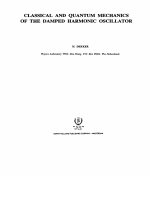
![Lecture notes on c algebras and quantum mechanics [jnl article] n lamdsman](https://media.store123doc.com/images/document/14/rc/rt/medium_6PjfnHupCQ.jpg)
